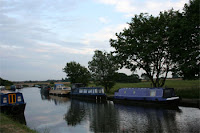
The image on the left is th original image.
1. A histogram shows the levels of black, white and mid tones in an image. It is a graph and lets you see quickly and easily the colours in an image or part of an image. The scale starts with black on the left and moves towards white. You use a histogram as a separate layer so that you can easily delete it or compare it to other variations by locking their view.
2. An
overexposed image is where there is too much white in it so it looks very light, this is due to too much light being in the picture. An
underexposed image is when there is too much black and it looks dull. This is where not enough light was present when the photo was taken. A correctly exposed image is where enough light is present in the picture so that it looks clear.
3.
Low key images are where the majority of the pixels on a histogram are towards the left. The picture is usually very dark.
High key images are where the majority of the pixels are on the right. The picture is usually very light.
4. Levels can be used so that the image can be corrected so that it looks real. By highlighting only certain parts of the image at a time, different parts of the image can be adjusted so that not all of it is changed. They can improve the contrast by making the colours look correct as if you were looking at them. You change the
hue and
saturation so that the image is improved.
5. The
magic lasso tool can be used to only highlight parts of the image. This is

useful if you want to change the levels for the sky in an image and not the foreground. Sometimes if you change the levels of a whole picture, the part you want to change will look good but other parts will not.
6. By using different
channels, I can change only certain colours such as red, green or blue. I used this to change the Chilean dessert. I increased the darkness of the red in the sand which made it look richer. I also cropped it to improve the
composition so that it followed the
rule of thirds. I made it so that the telephone poles are the subject and that they follow to the horizon. This gives an added feel of
perspective. Overall I am happy with it and I feel it has been improved. My final image is on the left.

 Another way to change the colour of a photo gram is to move the saturation all the way to the left to 0. This makes the image black and white. Then you click the colourise box under hue and saturation then you change hue until the picture is a colour you like. Below I did yellow to give the picture a washed out black and white look.
Another way to change the colour of a photo gram is to move the saturation all the way to the left to 0. This makes the image black and white. Then you click the colourise box under hue and saturation then you change hue until the picture is a colour you like. Below I did yellow to give the picture a washed out black and white look.







 As you can see for the red I changed the
As you can see for the red I changed the  I did this to make green, all I changed was the hue, which I changed to 100.
I did this to make green, all I changed was the hue, which I changed to 100. I like this effect and I think it would come to be very useful in the near future as I will be able to intensify parts of photos.
I like this effect and I think it would come to be very useful in the near future as I will be able to intensify parts of photos. 

 Overall I am happy with what I achieved as it improved the picture completely and made a bad photo look greatly improved even though it does look a bit
Overall I am happy with what I achieved as it improved the picture completely and made a bad photo look greatly improved even though it does look a bit



